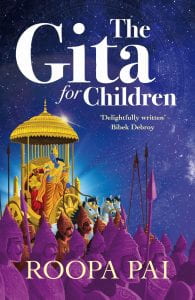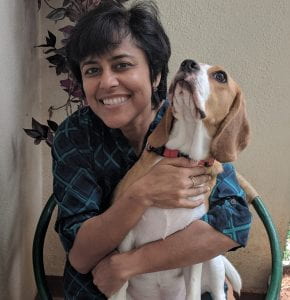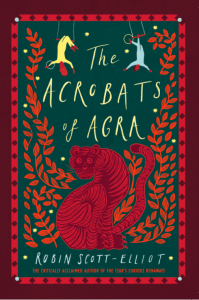I was delighted to be sent this story for review and then to be asked to take part in the blog tour. I knew that I  would probably love the book because the author is an alumni of Bath Spa University and their MA in Writing for Children. Over the years I have been lucky enough to know many of the staff and students and I know that the quality of writing is second to none. The book is a middle grade story, set in modern day India and it is an absolute stunner.
would probably love the book because the author is an alumni of Bath Spa University and their MA in Writing for Children. Over the years I have been lucky enough to know many of the staff and students and I know that the quality of writing is second to none. The book is a middle grade story, set in modern day India and it is an absolute stunner.
The story is told from the perspective of Lena, who is devastated by the sudden disappearance of her beloved elder brother Kay-Kay. He and his best friends were on their way back from a school summer camp in Goa, and at some point during the train journey he just seems to have vanished. Lena, like so many young people becomes frustrated by what she perceives are the slow reactions of the police and other authorities. In the end she decides to try and and find some answers for herself. Then begins a long and hazardous journey, following the train stations where Kay-Kay’s train stopped. On the way she meets a wide range of people and discovers a lot about herself, as well as finding out things that her brother had kept hidden from the family. However, the main question is always, where is Kay-Kay and can he be brought home?
This is one of those really magical books that you come across now and again. Lena is speaking directly to her brother and this really adds to the feeling of how personal the story is. When Lena discovers the poetry that her brother has kept hidden from his family, she is overwhelmed by the beauty and lyricism of the words and the pages become her constant companions as she undertakes her quest. We get a real sense of the reality of her environment and the incredible contrasts in modern India; it really makes me wish that I was able to visit and enjoy the country myself. I have a distinct feeling that this is now on my list of favourite books for 2024 and it has five stars from me. I am also delighted that Dev has written this short piece for the blog, speaking about using the second person in her writing, many thanks.
Dev Kothari: Writing in second person
I believe that the way a story is told is as important as the story itself. Sometimes when I write, I have to try writing a piece in many different ways, in different voices to find the one that works best for it. And some lucky few times, a story appears to me having already chosen the right form in which it wants to be told. That was the case with Bringing Back Kay-Kay which is told in Lena’s voice as if she’s talking to her brother, Kay-Kay, a form of second person narrative. I didn’t set out to write the story this way, but it felt right from the very beginning. Even so, as I carried on writing, I conducted further research, by reading other books written in second person. While I’d read a handful of adult novels that used this form, I hadn’t come across any children’s novels that did so. Upon researching I discovered Rebecca Stead’s beautiful, intriguing MG novel When You Reach Me, Lucy Christopher’s Stolen, a sensational YA novel, and E. L. Konigsburg’s delightful MG novel, From the Mixed-Up Files of Mrs. Basil E. Frankweiler. All of these books showed me different ways of how the second-person narrative can complement a story and more importantly, they helped strengthen my confidence in choosing this form too. Even so, I’d be lying if I said I had no apprehensions about how young readers would take to it. Since the book came out, however, I’ve heard from so many readers that it is this style of telling the story that seems to have immediately hooked them or helped them emotionally connect with the characters. So, I hope that the second-person narrative is one of the reasons why you might enjoy reading Lena and Kay-Kay’s story too.
Bringing Back Kay-Kay which is told in Lena’s voice as if she’s talking to her brother, Kay-Kay, a form of second person narrative. I didn’t set out to write the story this way, but it felt right from the very beginning. Even so, as I carried on writing, I conducted further research, by reading other books written in second person. While I’d read a handful of adult novels that used this form, I hadn’t come across any children’s novels that did so. Upon researching I discovered Rebecca Stead’s beautiful, intriguing MG novel When You Reach Me, Lucy Christopher’s Stolen, a sensational YA novel, and E. L. Konigsburg’s delightful MG novel, From the Mixed-Up Files of Mrs. Basil E. Frankweiler. All of these books showed me different ways of how the second-person narrative can complement a story and more importantly, they helped strengthen my confidence in choosing this form too. Even so, I’d be lying if I said I had no apprehensions about how young readers would take to it. Since the book came out, however, I’ve heard from so many readers that it is this style of telling the story that seems to have immediately hooked them or helped them emotionally connect with the characters. So, I hope that the second-person narrative is one of the reasons why you might enjoy reading Lena and Kay-Kay’s story too.
Bringing Back Kay-Kay by Dev Kothari (£7.99, Walker Books) available

 Why did you write The Gita for Children, and what age is it aimed at?
Why did you write The Gita for Children, and what age is it aimed at?
 able to care for Bea and the family packed Bea off to Aunt Constance. Unfortunately the year is 1857 and the city of Agra and the surrounding region are fast becoming the centre of a rebellion by the Indian troops. Bea and her relatives had just attended a performance of the Circus and but within days life has changed as the city of Agra finds itself under siege. Bea finds herself caught up in events and together with Jacques (an acrobat from the circus) and an Indian servant called Pingali manages to escape from the city and head for the hills, in an attempt to find her younger brother George. He had travelled to India with their parents and was sent to live with another aunt after their deaths. The dangers that this group face, both from the rebels and from army deserters brings them into huge danger and makes them very aware that you cannot judge people by their ethnicity or background. The epilogue at the end rounds off the story and we get an insight into how lives have changed over the three years since the rebellion.
able to care for Bea and the family packed Bea off to Aunt Constance. Unfortunately the year is 1857 and the city of Agra and the surrounding region are fast becoming the centre of a rebellion by the Indian troops. Bea and her relatives had just attended a performance of the Circus and but within days life has changed as the city of Agra finds itself under siege. Bea finds herself caught up in events and together with Jacques (an acrobat from the circus) and an Indian servant called Pingali manages to escape from the city and head for the hills, in an attempt to find her younger brother George. He had travelled to India with their parents and was sent to live with another aunt after their deaths. The dangers that this group face, both from the rebels and from army deserters brings them into huge danger and makes them very aware that you cannot judge people by their ethnicity or background. The epilogue at the end rounds off the story and we get an insight into how lives have changed over the three years since the rebellion.